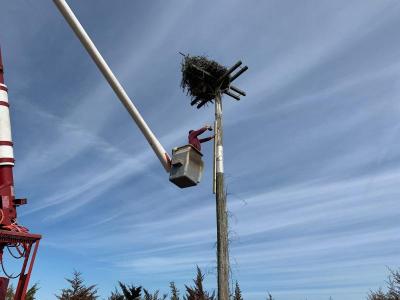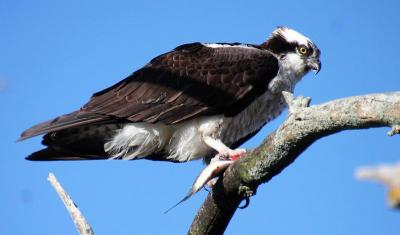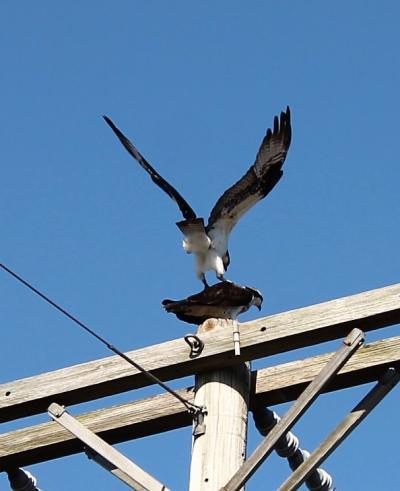Osprey return to Wareham
The sunshine is warmer, crocuses are blooming, daffodils are budding, and the ospreys are screeching.
A number of osprey have returned to their nests around town, including near the Narrows, the Agawam Herring Run, a nest near Nessralla’s, and near Parkwood Beach.
The osprey nest at Burgess Point in Onset got an emergency repair on March 24 as the Buzzards Bay Coalition hired Pontiac Tree Services to repair a crack in the pole supporting the nest.
Three osprey watched intently as the pole was stabilized. The coalition plans to completely replace the pole after the birds migrate south this fall.
The birds migrate to South America for the winter, and return each spring to the nest they used the previous year.
Osprey nests are built up high in relatively open areas so the birds can see any threats long before they arrive. Trees, utility poles, and specially-built osprey platforms are the most popular choices for nest locations.
The nests are composed largely of sticks, and can be quite large -- up to three to six feet across and ten feet deep. Osprey return to the same nest each year, and so the nests often get larger and more elaborate over time as the birds repair and expand it.
After spending some time courting and working on the nest, pairs of osprey will lay 2 to 4 eggs.
Both the male and female osprey take turns incubating the eggs for about 35 days before they hatch.
Chicks begin to fly when they are about 8 weeks old, after being nurtured and fed in the nest.
In the fall, young will fly south and remain in South America until they are two or three years old when they return to the north for the first time. Osprey typically breed for the first time when they are between three and four years old, and many mate for life.
Osprey are skilled at catching fish, which they spot from above before grasping them with their talons.
The Wareham Land Trust is hoping to get community members involved in OspreyWatch, a citizen science project tracking the breeding activity of osprey.
All participants need to do is find a nest and commit to spending thirty minutes watching it each week from March to October, and then submit information about what the osprey are doing to the Osprey Watch site. The data required is simple -- for example, one would note whether the osprey appear to be incubating eggs, or if there are chicks poking their heads out of the nest.
To learn more, email Land Steward Mike Perrin at stewardship@warehamlandtrust.org or go to osprey-watch.com.



.JPG)














